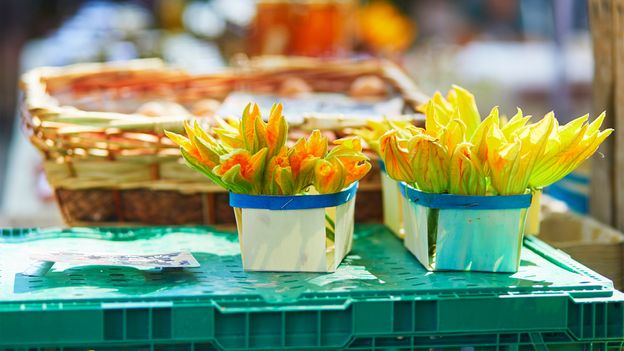No one knows for sure when or how locals in the South of France started eating fleurs de courgette (courgette flowers), but their simple philosophy endures: when life gives you courgettes, make stuffed courgette blossoms. Once an affordable, rural dish due to an abundance of produce, the trumpet-like bright yellow flowers have found their way onto tables at Michelin-star restaurants.
Alain Llorca, chef and owner of his eponymous one-star restaurant, about 18km from Nice in La Colle-sur-Loup, is fond of the dish, which has become one of his signatures (see recipe below). Often stuffed with creamy ewe’s milk cheese aged for months before being blended with ingredients like locally grown aubergine, basil and olives, he says that his stuffed courgette flowers “highlight other flavours from the South of France”.
However, his elevated version of the dish is a far cry from its humble origins, even within Llorca’s own family, where they would dip the blossoms in batter and pan fry them with herbs. “We eat them like that, hot or cold, on a picnic at the beach,” he said. Courgette flowers are a speciality of the region, where many people are also accustomed to making clever use of leftovers at home. “It may be a family way of making courgette,” he explained. “We collect everything that we don’t eat the day before to put in the flower.”
Llorca wasn’t the first chef to take courgette flowers from rags to riches, so to speak. About 30 to 40 years ago, an ingenious chef – Jacques Maximin, who worked in the kitchen of the opulent Hotel Le Negresco in Nice – began cooking the courgette and blossom in a new way, elevating and popularising the region’s emblematic dish into a work of culinary art.
Traditionally, the male flower, located at the end of a stem of a courgette plant was stuffed or fried, while the female flower blooming at the end of the vegetable was discarded. But, feeling that courgettes were to too big and long for his envisioned dish, chef Maximin worked with local farmers to grow a petite, tender courgette variety with the female flower still attached to it so that he could make an elegant dish using both the body and the flower together. Other chefs soon followed suit.

